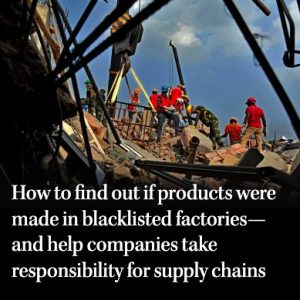The supply chain begins with farming and harvesting cotton. Workers then weave together the fibers to create yarn. Next, manufacturers buy the material to sew together into garments ranging from T-shirts to dresses before shipping them off to retailers across the globe.
But hidden behind each piece of clothing are the laborers who create it. The workers often were forced to produce it with little to no pay.

Two researchers are pairing up from across the Atlantic to stem this practice by creating a free forced labor data hub. The aim is to showcase the risk of forced labor used in products and to persuade companies and consumers to buy from alternative sources.
“For Northeastern to offer this at no cost because we’re being funded through a grant is, in my eyes, revolutionary,” says Shawn Bhimani, an assistant professor of supply chain and information management at Northeastern. “We’re trying to create a direct impact in the industry.”
The collaboration between Northeastern University and Sheffield Hallam University in England is being funded with a $275,000 grant.
The project will establish a free online supply chain data hub that will use machine learning to map, analyze and connect potential human rights violations to corporate supply chains.
In the first year of the grant, the pair is looking into apparel companies in Xinjiang but will scale it out in the future.
Five to eight private companies will sell this information for a very high cost, Bhimani says. Only governments and large corporations can afford to access the information, “which leaves everyone else in a lurch,” he says.
Journalists, advocates, consumers, and small and medium-sized companies can’t access this information, Bhimani says.
“Our goal is to democratize access to that information to make it such that anyone, anywhere, can access those corporate relationships with forced labor for free,” Bhimani says.
Forced labor is often unidentified and unaddressed in global supply chains because international production networks are complex and obscure. Many companies are not actively tracing their supply chains beyond the first or second tiers, leaving out the complete picture of the origin of their raw materials.
The hub will automatically parse, import, and export shipping data to map global supply chain imports and connect it to supplier links between multiple tiers. It will also use the information collected on at-risk supply locations.
Not tracing materials exposes companies to forced labor violations, which can have significant legal, financial and reputational risks.
Consumers want to know the origins of their Gap T-shirt, says Murphy, Professor of Human Rights and Contemporary Slavery at Sheffield Hallam University. Law firms want to sue companies that are doing things wrong. “But more importantly, we’re approached by companies struggling to figure out how to do this.”
Why is it so difficult to track? “China,” says Murphy. “Or the other answer is, it’s a crime.”
Tracing criminal activity in supply chains is not surprisingly intentionally obscured, Murphy says. While there are some things you can see where products come from, usually, you can only get back to the immediate manufacturer or the person who stitched the clothes together.
For example, a package might say it is being shipped from FedEx to FedEx but carrying a piece of clothing.
Knowing where the cotton comes from, the polysilicon, or the semiconductors for the solar panels, Murphy says, are many tiers back in the supply chain.
“It’s difficult, especially for a consumer, but even for companies to know,” says Murphy.
The project starts with the Uyghur region because, Murphy says, “it is such an urgent issue and because it is so pervasive internationally.”
“This system of forced labor is unlike anything I’ve ever seen,” says Murphy. “And we hope it is the worst thing we’ll ever see in our lifetime. So that creates a sense of urgency.”
The U.S. government has taken a strong stance against this, with others following. The Uyghur Forced Labor Prevention Act (UFLPA), which began in June 2022, gives US authorities increased powers to block the import of goods linked to forced labor in China.
However, there isn’t much capacity to parse all this information and understand what is happening.
“Our hope is to be able to give them the tools they need to … do the right thing,” says Murphy.
Beth Treffeisen is a Northeastern Global News reporter. Email her at b.treffeisen@northeastern.edu. Follow her on Twitter @beth_treffeisen.

